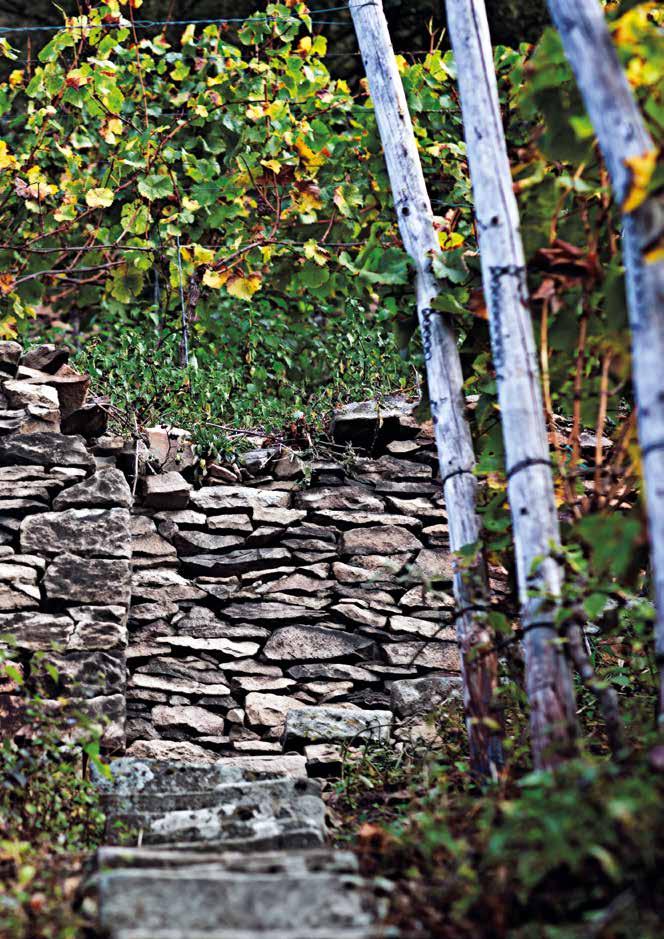
37 minute read
German Winegrowing Regions
Bad Neuenahr-Ahrweiler Bonn · Rhein Bad Bodendorf
Marienthal ·
Advertisement
Altenahr · · Mayschoß
Ahr
Vineyard area: approx. 560 ha, 83% red wine Most important grape varieties: Spätburgunder, Frühburgunder, Riesling Further information: www.ahrwein.de
• Vinothek of the Jean Stodden red wine estate • Mayschoß: Cradle of winegrowers’ cooperatives • Marienthal Monastery: Wine tasting in the vaulted cellar
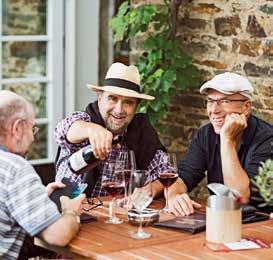
Ahr – The Valley of the Reds
The Ahr is one of the smaller winegrowing regions, with only about 560 hectares of vineyards. What sets it apart: red varieties represent 83 percent of the grapes grown here, a higher proportion than in any other German winegrowing region. Spätburgunder (Pinot Noir), Portugieser and Frühburgunder predominate, while Riesling is the most important white variety.
The region takes its name from the Ahr River, which flows into the Rhine roughly 40 kilometers south of the former federal capital Bonn. The slopes of the picturesque Ahr Valley mostly face south, which lends itself well to winegrowing. Little rain falls here and throughout the year average temperatures remain quite low. Pinot Noir, a demanding variety by nature, grows well in the Ahr because the soil matches its needs. The Ahr Valley is part of the Rhenish Massif, which is notable for the heavy slate content of its soils. During the day that slate stores heat, only to release it again at night – like natural underfloor heating! The river also helps balance out climatic fluctuations.
Red Wine Trail along the Ahr Valley
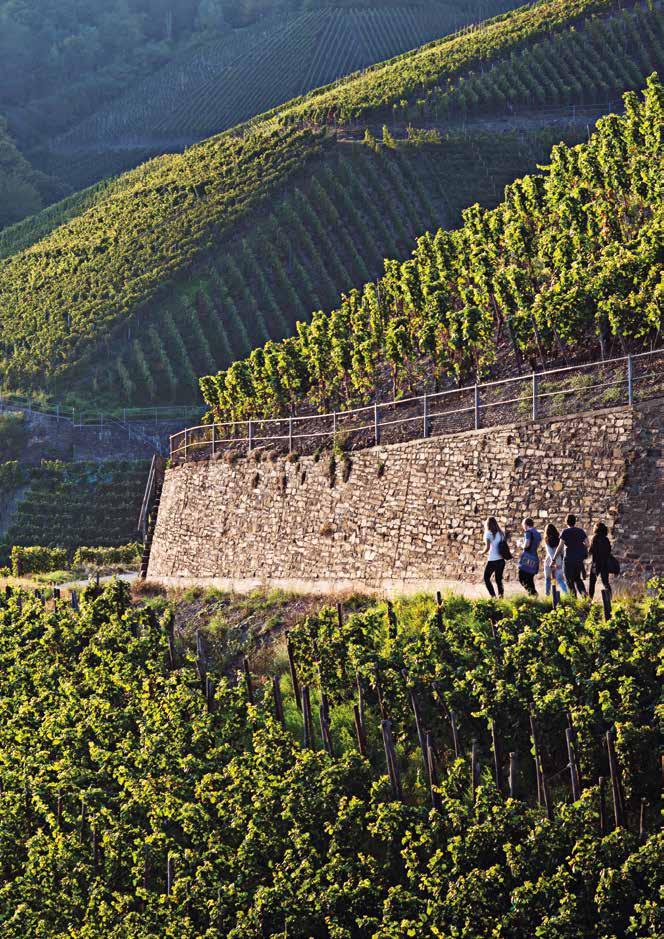

Scenic view of Ahrweiler’s historic city center
The Ahr River has spent two million years carving its way through the slate mountains. The valley is narrow and the slopes are steep, especially at the Mittelahr, its geographic middle section. This wild and romantic valley is the most diverse botanical region of the Rhenish Massif and a habitat for rare animal species. Here the wild cat and the eagle owl bid each other good night.
PINOT NOIR IS UNCHALLENGED AS THE MOST POPULAR GRAPE VARIETY IN THE AHR.

It only arrived in the region after the Thirty Years’ War, although other vines had already been cultivated there by the Romans since the first century AD. Ahr red wines are elegant and complex and have good aging potential. Wine festival on the Ahr
The first winegrowing cooperative in Germany, and one of the first anywhere in the world, was founded in Mayschoß in 1868. It arose from necessity: a series of bad harvests and oppressive duties meant that many winemaking families could no longer subsist from the products of their own winery alone. Some emigrated, others joined together to operate a collective wine cellar. It is an idea that still works well even today – not only in the Ahr region!
Baden – Sun-Ripened and Pinot Perfect
Heidelberg ·
Karlsruhe ·
Rhein
Stuttgart ·
· Ihringen · Freiburg Meersburg
Reichenau
Vineyards in Baden, near Durbach If you think the weather in Germany is mainly cold and uncomfortable, you should visit Baden! Located in the southwest of Germany, the growing region stretches from Tauberfranken in the north via Heidelberg along the Rhine down to Lake Constance. With almost 16,000 hectares under vine, it is the country’s largest wine region.
Baden is characterized by a notably mild climate. This is mainly due to the Belfort Gap, a plateau between the rock formations of the southern Vosges mountains and the northern Jura mountains. Here, the mild Mediterranean air currents stream into the Upper Rhine Plain. For this reason, Baden is the only German wine region which is part of the EU wine-growing zone B, which is reserved for the warmer areas of Europe. Because of the Belfort Gap, it is said, Baden is Pinot country: Pinot Noir, Pinot Blanc and Pinot Gris all thrive here.
One local speciality is the rose-coloured wine called Badisch Rotgold. This is not a distinct grape variety but rather a special cuvée made from Pinot Gris and Pinot Noir.
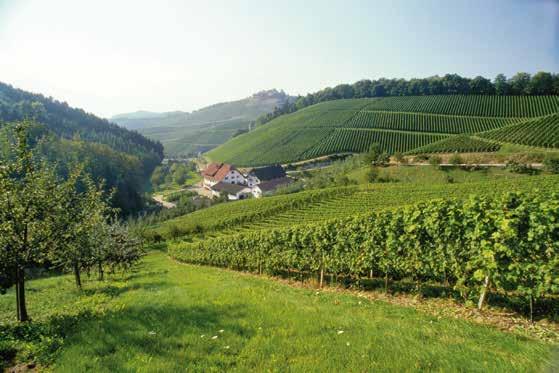

Scenic view of the vineyards at Oberbergen, Kaiserstuhl
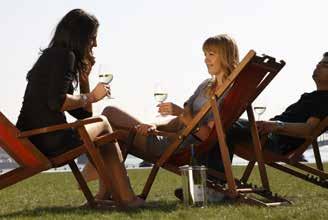
Baden is divided into nine districts: Bodensee, Markgräflerland, Tuniberg, Kaiserstuhl, Freiburg, Ortenau, Kraichgau, Badische Bergstraße and Tauberfranken. A diverse range of soil profiles spreads across them: from shell limestone and keuper in the Kraichgau and lime, clay and marl deposits on the banks of the Tauber to rich loess and clay soils with volcanic debris in the Kaiserstuhl, Tuniberg and Markgräflerland.
Among the excellent white wines from Baden is the “Klingelberger,” which is simply the traditional Ortenau name for Riesling. The name stems from the Klingelberg vineyard, part of the Schlossberg at Durbach where Margrave Carl Friedrich of Baden, master of the Staufenberg Castle winery, ordered Riesling planted in 1782. This decision to plant the vineyard with only one single variety was an innovation at that time.
THE KAISERSTUHL GETS THE MOST SUNSHINE IN ALL OF GERMANY.
This volcanic cone between the Black Forest and Vosges mountains, with an average temperature of over 11 degrees Celsius, is undoubtedly one of the warmest places in the country. This leads to an endemic flora and fauna which is quite unusual for Germany: 36 orchid species are native to the Kaiserstuhl as well as 729 species of butterflies, the colorful bee-eater bird, long green lizards that measure up to 40 cm and the praying mantis. The name Kaiserstuhl (“Emperor’s Seat”) dates back to Emperor Otto III (980-1002), whose court was located in the “Gestühl,” a section of Leiselheim. That link is still reflected in a local vineyard name even today.
Baden has made a name for itself far beyond its borders for its high concentration of gourmet restaurants. Few other regions of Germany boast as many restaurants with star chefs. Word has certainly spread to the French Alsace, and cross-border culinary tourism is on the rise, including from other parts of Germany and Switzerland.
Vineyard area: Approx. 16,000 ha, 59% white wine Most important grape varieties: Spätburgunder, Müller-Thurgau, Grauburgunder, Weißburgunder, Riesling Further information: www.badischerwein.de
• Weingut Abril Vogtsburg-Bischoffingen • Vineuem Bodensee • Reichenau – where wine is cultivated in water • The Great Vat in Heidelberg Castle • Volcanic rock garden at the Winklerberg in Ihringen

Scenic view of idyllic Escherndorf
· Aschaffenburg
Main
· Würzburg · Kitzingen
Vineyard area: approx. 6,100 ha, 81% white wine Most important grape varieties: Müller-Thurgau, Silvaner, Bacchus Further information: www.frankenwein-aktuell.de
• Staatlicher Hofkeller Würzburg • Sommerach am Main: In the realm of the senses • Weingut Brennfleck in Sulzfeld am Main • Vinothek of Max Müller I Weingut in Volkach • Weingut am Stein in Würzburg • Vinothek Iphofen • Staatlicher Hofkeller Würzburg • Bürgerspital zum Heiligen Geist winery • Juliusspital in Würzburg • Castell and Silvaner
The Hofkeller in Würzburg
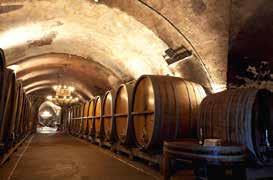
Franken – Fine-Wine-Main

The section of Franconia that runs along the Main River is called “Mainfranken,” but many feel it ought be renamed “Wine Franken” to reflect the wonderful tradition of Franconian wine produced along the Main River and its tributaries. The region’s wines are known far and wide for the distinctive Bocksbeutel, a flat, bulbous bottle. It is unclear how this unusual bottle shape came to be associated with this particular region, but excavations in the Franconian town of Wenigumstadt unearthed an ancient bottle of Celtic origin, dating back to 1400 BC, that had a similar flat, bulbous form. Is it the missing link? The Bocksbeutel is certainly quite practical: It doesn’t roll down slopes! Good for a picnic in the gently rolling hills of Franconia’s river valleys.
Franken is the only German winegrowing region located entirely within the borders of Bavaria, Germany’s southeastern-most federal state. The region’s roughly 6,000 hectares are mostly situated in the vicinity of the baroque town of Würzburg.
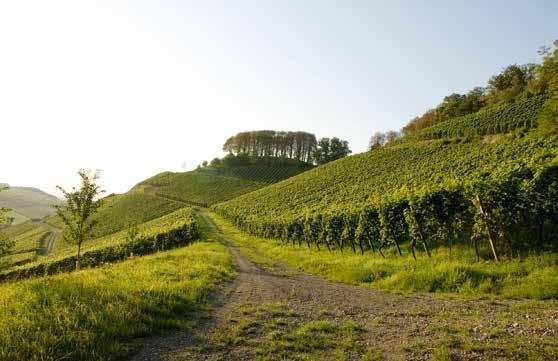
Landscape near Castell
THIS RECREATIONAL PARADISE ALSO FEATURES MANY PICTURESQUE TOWNS SUCH AS IPHOFEN AND CASTELL.
81 percent of the vines cultivated in Franken are white grape varieties. Silvaner is considered the classic Franconian variety, and no other region has a higher proportion of Silvaner. It was planted for the first time at the Schlossberg in Castell in April 1659. Its character is often compared to that of the inhabitants of Franken themselves: quiet and restrained, but of rock-solid power. Silvaner ripens two weeks earlier than Riesling and produces good yields but is susceptible to harsh winters. For this reason, it is not the most commonly grown grape variety in Franken. In order to achieve a certain stability of yield, many vineyards were planted with the more climate-resistant Müller-Thurgau. The white Bacchus, which can be matured into anything from simple sundowners to fancy Auslese is also very dear to the Franconian winemaker’s heart. A red grape specialty from Franken is the Domina. The climate in the Franken wine country is mostly continental, but the Main has a balancing effect: the summers are hot and the winters cold. Mainfranken is protected from excessive cold and rain by the Rhön Mountains to the north and the Spessart to the west. And although there is little rain around Würzburg in summer, humidity is relatively high. The sparse precipitation has led to a high concentration of mineral content in the soil. It should come as no surprise that minerally, earthy undertones are among the main markers for classic Franken wines.
“Steinwein” has long synonymous with Franken wine. The term refers to the “Würzburg Stein,” one of Franken’s most famous vineyards — and coincidentally the oldest documented named vineyard site anywhere in Germany. A 1540s Steinwein is still stored today in the cellar of the Bürgerspital winery in Würzburg. Johann Wolfgang von Goethe, Germany’s national poet, was a noted connoisseur of Steinwein. On 17 June 1806 he wrote to his wife Christiane: “Please send me some Würzburg wine, no other wine tastes as nice and I will surely become surly if I miss my favorite drink.”
Hessische Bergstraße –Spring Meadows, Island of Wine
Rhein Main
· Darmstadt
· Zwingenberg The 467 hectares under vine of this smallest German wine-growing region stretch mainly on the gentle slopes of the Odenwald hills along the
Rhine. “This is where Germany starts to be Italy,” Joseph
II proclaimed as he traveled from Frankfurt across the
Bergstraße (Strata Montana) as the newly crowned Emperor of the Holy Roman Empire of German Nations in
April 1766. Spring does indeed arrive here earlier than anywhere else in Germany. Figs and almonds, forsythia and magnolias all thrive at the Bergstraße just as well as vines. On a clear day you can see as far as the Pfälzer
Wald (Palatinate Forest). This was certainly among the reasons why so many castles were constructed along the
Bergstraße.
Add to this the partly terraced vineyards – this region is beautiful throughout the year, not just when the fruit trees are in bloom! The soils of the Hessische Bergstraße are characteristically dry, with shifting sands that warm easily and are low in nutrients as well as deep, finegrained loess known for storing water well.
Riesling is the “King of the Bergstraße.” It makes up just under half of the vines planted here and thrives especially well on the Bergstraße because of the long growing seasons. The remaining 59 percent of vineyards
MOST TOWNS AND VILLAGES IN THIS AREA HAVE HISTORICAL CENTERS WITH PICTURESQUE FLAIR.
Kloster Lorsch · · Heppenheim
· Mannheim
Heidelberg ·
Almond blossoms along the Hessische Bergstraße


Heppenheim Stemmler
Among wine fans, the Odenwald forest is known for its unusual “island.” This is of course not a real island, but rather a small winegrowing region called the Odenwald Wine Island that sits slightly separated from the rest of the Hessische Bergstraße. Its 62 hectares are located around the town of Groß-Umstadt, west of Darmstadt and relatively close to the Hessian metropolis of Frankfurt am Main. That city actually has its own vineyard, the Lohberg, but it is classified as part of the Rheingau region. Furthermore, Frankfurters are famously partial to a different kind of wine – “Ebbelwoi,” which is made from apples.
Vineyard area: approx. 470 ha, 79% white wine Most important grape varieties: Riesling, Grauburgunder, Spätburgunder Further information: www.bergstraesser-wein.de
• “Wine and Stone” adventure trail at Heppenheim • Lorsch Monastery and the history of viticulture in this region share different varieties, such as MüllerThurgau, Gewürztraminer and the rare yellow Orleans. In recent years red grapes have also seen an increasing share of vineyard space. These include Pinot Noir, Pinot Madeleine and Saint Laurent.
The Romans were probably the first winegrowers in the region. having noted its mild climate. The Bergstraße was an important trade route, and they called it “Via Strata Montana.” The Geo-Naturpark Bergstraße-Odenwald is one of the 77 regions worldwide which have been admitted into the UNESCO Global Network of Geoparks. 500 million years of the history of the earth are visible on 2,230 square kilometers between Rhine, Main and Neckar. The Hessische Bergstraße with its location between the Upper Rhine Plain and the crystalline Odenwald is an important part of the Geopark.

Scenic view of Heppenheim


Mittelrhein –Loreley loves Riesling
·Königswinter Rhein
·Neuwied
Koblenz· Lahn
Boppard·
Bacherach·
Bingen·
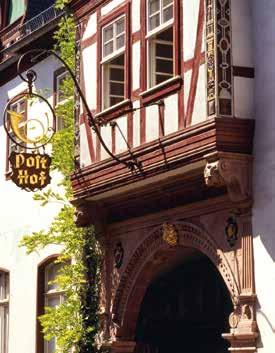
Romantic hotel in Bacharach
Vineyard area: approx. 470 ha, 85% white wine Most important grape varieties: Riesling, Spätburgunder, Müller-Thurgau Further information: www.mittelrhein-wein.com
• Boppard Hamm: the wine loop on the Rhine • Bacharach: Heart of the Romantic Rhine The Romantic Rhine has long played a prominent role in the imaginations of foreign tourists. Back in the 19th century, Victor Hugo and Mark Twain each raved about the spectacular scenery, while William
Turner found inspiration for his many paintings. Unlike most Germans, it’s not hard to find tourists from Japan or
Korea who can sing the opening lines to Heinrich Heine’s
Loreley song by heart: “Ich weiß nicht, was soll es bedeuten...” For wine connoisseurs, the Mittelrhein starts and ends with Riesling. The cultivated area of the Mittelrhein measures 470 hectares, stretching along 110 kilometers of the Rhine from Bingen to the Siebengebirge at the gates of the former federal capital Bonn.
Anyone who has ever traveled along this route by train, ship or car will remember many medieval castles, picturesque towns… and omnipresent vineyards.
THIS ROMANTIC ROUTE BETWEEN BINGEN AND KOBLENZ WAS DECLARED A UNESCO WORLD HERITAGE SITE IN 2002!

Scenic view over the Pfalzgrafenstein
Drinking the wines may be romantic but producing them is certainly not. Most vineyards here are located on steep slopes that challenge winegrowers to the utmost. But the wines from the Mittelrhein region are worth the effort: the predominant slate soils yield hearty, mineral-rich wines with lively acidity.
Mild breezes are frequent here, although the Hunsrück keeps the coldest flows away. As elsewhere, south-facing slopes are essential for producing top wines. These are found from the bend in the Rhine near Boppard to the Loreley primarily on the right bank of the Rhine; to the north of that stretch up to Rhens on both banks, and to the south of it down to Trechtingshausen especially on the left bank and in its side valleys. More than 300 hectares of the region’s vineyards are planted with Riesling. Pinot Noir, Müller-Thurgau, Blauer Portugieser and Kerner from the Mittelrhein are typically enjoyed locally and therefore rarely find their way past its borders.
The impressive castles were once built as defensive structures or customs stations but lost this significance from the 15th century when firearms were invented. Many castles were abandoned. The Thirty Years’ War (1618-1648) and the War of the Palatinate Succession (1688-1692) caused a lot of destruction – the glory of the magnificent fortresses of the Mittelrhein seemed to be over. But many of the thick walls survived the centuries, were restored from public and/or private funds and are today a symbol of the Romantic Rhine – together with the vineyards, of course!

The town of Bacharach has several distinctive steep slopes. According to an old saying the best wines are grown in Bacharach, and Pope Pius II had a barrel of Bacharach wine delivered to Rome every year. But there is also a very flat vineyard. It is situated on a 680 by 150 meter island in the Rhine and is called “Heyles’en Werth” after its former owner Hans Heyles. Today the island is cultivated by a winemaking family from Bacharach. Unlike their vintner colleagues with steep slopes, they need muscular arms to go along with strong legs... as the island can only by reached by rowboat!
Mosel – Romans, Riesling and Steep Slate Slopes
The Mosel is second perhaps only to Father Rhine when it comes to most famous German wine rivers. Known as ‘La Moselle’ as it wends through France and ‘Musel’ for its stretch through Luxembourg, the magnificently meandering river becomes the ‘Mosel’ at Perl, from whence it travels 250 kilometers across German soil to meet the Rhine at Koblenz. This is the oldest German winegrowing region, with odes in its honor composed by the Roman poet Ausonius, and it covers a total of almost Rhein Mosel Cochem · · Traben-Trarbach ·ZellBremm· 8,800 hectares of vineyards, with viticulturally notable tributaries Saar and Ruwer. The wind along the Mosel comes mainly from the southwest. River and soil both store warmth during the day and release it at night. The steep rocky slopes along the Mosel mean the sun’s rays hit Piesport· ·Bernkastel-Kues the ground almost vertically, especially at the Bremmer Calmont, the steepest vineyard in Europe. This gives rise · Trier to a very mild microclimate that sustains life for numerous plants and animals that would otherwise perish if forced to live or grow just a few kilometers away in the Eifel or Hunsrück Mountains: the kingfisher, Apollo butterfly, green lizard, stonecrop and rustyback fern have all made a home for themselves here.
Steep vineyards in Kröv

Vineyard area: approx. 8,800 ha, 91% white wine Most important grape varieties: Riesling, Müller-Thurgau, Elbling Further information: www.weinland-mosel.de
• Weingut Lubentiushof in Niederfell an der Mosel • The Roman wine presses of Piesport • Vineyard sundials at the Mosel • Winery of the Vereinigte Hospitien in Trier • Traben-Trarbach • Bremmer Calmont
ARCHEOLOGICAL EVIDENCE SHOWS THE CELTS SETTLED AT THE MOSEL.
The Romans later had a profound impact on the region, especially its viticulture. In roughly 50 BC, Julius Caesar went to war against Gaul and traveled through the Mosel Valley on his way there. In 15 BC, the Romans founded Augusta Treverorum, today’s Trier, which in the 4th century would become the seat of government of the Western Roman Empire and grew into the largest town north of the Alps.
The Upper Mosel, a stretch of the river running from the border triangle of France, Germany and Luxembourg to the confluence with the Saar at Konz, features shell limestone and keuper soils —an excellent basis for the Pinot varieties and the domestic Elbling. Slate predominates from Schweich to Koblenz, where the Mosel has slowly and persistently carved a gorge into the Rhenish Massif. Many vineyard names on the Mosel end in “-lay,” indicating that the vines are planted on slate. There is solid history behind this; the ancient Celtic term for slate, “ley,” has survived the ages in this way.
The river is known for its spectacular, often terraced slopes on both right and left banks as well as its many curves and turns. Riesling thrives especially well in the slate soils of the Middle Mosel and Lower Mosel, where it is forced to dig deep to find the minerals and nutrition it needs in this barren substrate. Mineral elegance, an almost playful finesse and an often delicate residual sweetness characterize Mosel Riesling.

The most expensive sale of a vineyard to date took place in 1900, when the mayor of Bernkastel sold 4,300 square meters of the vineyard named “Doctor” to a certain Carl Wegeler – for 100 gold marks per vine. In today’s money that would be about 600 to 700 Euro per vine. The investment has proven its worth over the long term, as the vineyard is now one of the most famous in the world and the finest in the region. Its peculiar name derives from the fact that in 1630 Archbishop Bohemund of Trier took ill but unexpectedly recovered after a few sips of wine. In gratitude he awarded the title of Doctor to the vineyard.
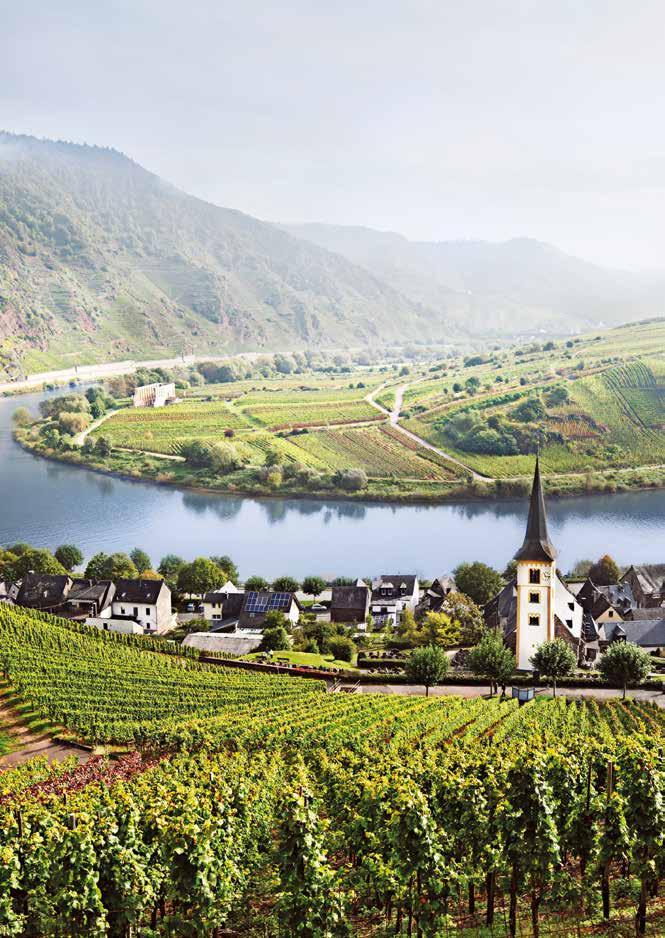

Vineyards on the Rotenfels
Nahe – Slow River, Craggy Cliffs
Schloß Böckelheim Rhein
· Bingen
Bad Sobernheim ·
Nahe
Kloster Disibodenberg
· Bad Kreuznach Precious stones are small, but brilliant. This description also fits the nearly 4,200 hectares of the Nahe region, which is sometimes called a “treasure chest” in its own right. Many excellent wines from varieties such as Riesling, Pinot Blanc, Pinot Gris, Kerner, Müller-Thurgau and others can be found here. Quite a few Nahe vintners rate among Germany’s top producers.
The Nahe River arises near Nohfelden-Selbach in the Saarland and flows into the Rhine near Bingen. The sixty kilometers of river starting at the river mouth are part of the growing region. This includes the valleys of the tributaries Alsenz and Glan.
The Hunsrück shelters this quiet, idyllic area from rain. The sun shines for approximately 1,750 hours per year. The temperature of the steep cliffs can reach up to 60 degrees Celsius in the summer – the vines don’t mind, as they enjoy having warm feet during the growth period!
NO OTHER REGION OFFERS SO MANY DIFFERENT TYPES OF SOIL IN SUCH A SMALL SPACE.
Klostermühle in Odernheim
The Nahe area is located at the intersection of the Rhenish Massif, the Mainz Basin and the hilly landscape of the Saar. Volcanic rock, slate, red slate, quartzite, clay, loess, red sandstone and basalt can be found here, to name but a few. It is a versatile testing ground for vintners and a veritable playground for wine connoiseurs. Riesling is grown on about 27 percent of the growing area. Among
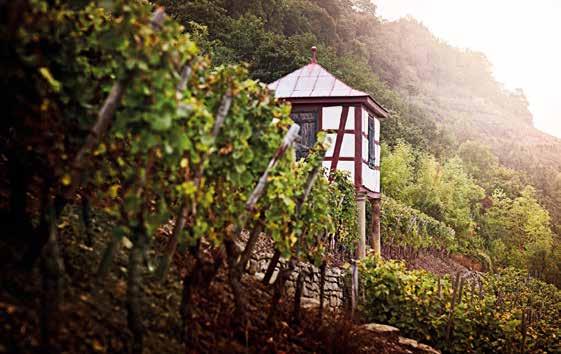
Like almost every German winegrowing region, the Nahe has its own wine route. The Nahe vintners have put their own local twist on it by collaborating with the German Gemstone Route. The pairing is logical; the gemstone capital of Germany, Idar-Oberstein, is close by. Each year a new special decorative bottle is designed. Each of these “Edelschliff” (‘noble cut’) bottles is furnished with a precious stone on the outside— sodalite in 2018 — and a liquid gem on the inside: a limited edition wine from the Nahe!
the red varieties Dornfelder and Portugieser dominate the field, but Pinot Noir is also grown here. It is truly a remarkable cross-section of German wine.
Hildegard von Bingen (1098-1179) lived and worked on the Disibodenberg at the Nahe. Her holistic approach to medicine, still considered relevant today, assigned a very important role to wine. In 2010, the Disibodenberg was honoured by the German Wine Institute as a “Landmark of Wine Culture.” As viticulture on the Disibodenberg dates back to at least the 11th century, the oldest vines in Germany are located here.
Wines from the Nahe were once referred to as “Rhine wine.” The character of Nahe Riesling is indeed reminiscent of wines from the Rhine and the Mosel, yet it also has its own distinctive “Nahe touch.” The Nahe was defined as an independent winegrowing region by the revised Wine Law of 1971.
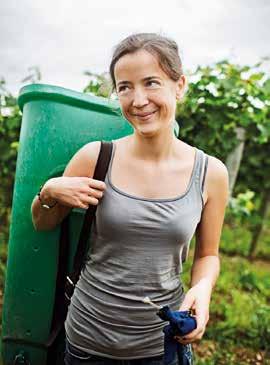
Open Air Museum in Bad Sobernheim

Vineyard area: approx. 4,200 ha, 75% white wine Most important grape varieties: Riesling, Müller-Thurgau, Dornfelder Further information: www.weinland-nahe.de
• Monastery ruins of Disibodenberg • Schlossböckelheimer Kupfergrube • Open-Air Museum Bad Sobernheim

Pfalz – Unforgettable Discoveries on the German Wine Road
Main
Ludwigshafen ·
Neustadt an der Weinstraße · Deidesheim Speyer ·
· Rhodt unter Rietburg
Rhein
Rhodt unter Rietburg
The beautiful Pfalz, marked by a gentle climate, is bounded on all sides by nature and wine. The largest contiguous forest area in Germany, the
Pfälzerwald (Palatinate Forest), stands to the west, while
Rheinhessen lies to the north, Baden across the Rhine
River to the east and Alsace to the south. Vines grow in the southeast of this region in the foothills of the
Pfälzerwald. Many vines, in fact: 23,500 hectares of vineyards here make the Pfalz the second largest wine growing region in Germany. There are 144 winegrowing communities in the region, most bordering the Deutsche
Weinstraße (German Wine Road). Opened in 1935, it is the oldest German wine tourism route and stretches roughly 85 kilometers from Bockenheim in the north to
Schweigen on the French border, terminating at the German Wine Gate.
The weather is often lovely here, and from higher elevations you can enjoy the beautiful views across the
Rhine plains to the imperial cathedral in Speyer or to
Heidelberg on the other side of the Rhine. The climate on the Weinstraße is almost Mediterranean and is hospitable to almonds, figs, lemons and olives. Each spring, almond blossoms immerse the Weinstraße in bright pink, marking the first festivals of the year in a region rich in wine festivals.
Vineyards in Ilbesheim

The Deutsche Weinstraße passes through many classic wine villages with halftimbered houses with grapevines that span the road. Each year on the last Sunday in August, the entire German Wine Road is reserved strictly for pedestrians and cyclists, turning into an 80-kilometerlong wine festival with more than 300,000 cyclists, walkers and skaters!
RIESLING IS THE FAVORITE CHILD OF PFALZ WINEGROWERS, WHO TYPICALLY PRODUCE IT FULL-BODIED AND JUICY.
Roughly 5,800 hectares of the Pfalz are cultivated with Riesling, a volume unmatched anywhere in the world. The second most common variety is Dornfelder, known and loved here as an easy-going red. Many other grape varieties thrive here as well. Where such wines correspond to the classic Pfalz profile, especially historical regional varieties such as Weißburgunder, Grauburgunder, Spätburgunder and, of course, Riesling, they may be marketed under the label DC Pfalz, which stands for Districtus Controllatus and indicates that wine was produced for regional typicity.
The Pfalz winegrowing region can be roughly divided into two subsections: the northern part, extending roughly from Neustadt an der Weinstraße to the Zellertal near Worms, is called the Mittelhaardt. Its soils are tendentially light and highly water permeable, and so the vines here must be deep rooted. Riesling is an important variety in this sub-region. At the Südliche Weinstraße (Southern Wine Route) from Neustadt to Schweigen in the south, the vines grow on heavier clay soils. There, in addition to Riesling and red wines, very good wines are made from Pinot varieties. Statistically speaking, there are 600 vines for every inhabitant of this Südpfalz subregion!
Incidentally, the largest wine festival in the world is celebrated in the Pfalz: the Dürkheimer Wurstmarkt (Sausage Market). This festival was originally opened for pilgrims in the 15th century. Even today, sausage is plentiful at this market, as are bread and wine. The festival was officially called the “Wurstmarkt” for the first time in 1832.

Vineyard area: approx. 23,600 ha, 65% white wine Most important grape varieties: Riesling, Dornfelder, Müller-Thurgau, Spätburgunder, Grauburgunder Further information: www.pfalz.de/wein-und-genuss
• Classic modernism in Kindenheim • The Roman vineyard in Ungstein • Rhodt unter Rietburg • Deidesheim: small wine village – great politics • Wine Museum in Speyer
Rheingau –Historic Hillsides on the Rhine
Kloster Eberbach Rhein
· OestrichWinkel Main Eltville ·Rüdesheim · · Wiesbaden · Mainz The Rheingau extends from west of Frankfurt along the Rhine, which in this region twists and turns based on nature’s whims. For most of its path from Alps to the sea, the Rhine flows south to north, but here near Mainz it makes a sharp bend, almost exactly at a latitude of 50 degrees north. It then flows from east to west past fabled villages such as Eltville, Oestrich-Winkel and Rüdesheim to Assmannshausen. The slopes of the Rheingau face due south, enjoying as much as 1,600 hours of sunshine per year. The Taunus Mountains to the north provide natural protection against cold winds and shield against excessive rainfall.
RIESLING IS THE UNDISPUTED KING AMONG THE GRAPE VARIETIES.
This demanding, late-ripening variety feels particularly at home here, developing a characteristic mineral touch and fresh fruit acidity. Spätburgunder, like Riesling, is counted among the noble grapes and thrives especially well around Assmannshausen. The Rheingau is a very popular tourist destination, with ancient monasteries and castles nestled idyllically amidst the wine landscape. The Rheingau Riesling Route leads through 120 kilometers of picturesque wine villages, where wine taverns and seasonal wine bars invite you to stop for a glass of Rheingau wine, in many cases directly at the winery. There are
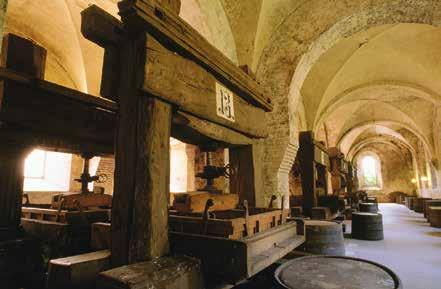


It’s not uncommon even today to hear someone in England order a glass of “Hock,” meaning a German white wine from the Rhine. The term refers to Hochheim am Main, a village located in the Rheingau. The love affair between Britain and Hochheim wines probably blossomed after Queen Victoria visited the town in 1845. She deemed its wines not just delicious, but also good for the health, giving rise to the saying “a bottle of Hock keeps off the doc!” Even a century ago wines from the Rheingau were among the most expensive on wine lists throughout the world, and especially in England.
plentiful cultural and historical attractions as well, such as the Oestrich wine loading crane from 1744. It is the last remaining one of its kind on the Rhine and was once essential for loading barrels of Rheingau wines onto river ships to destinations throughout the world. Any visit to the Rheingau’s highlights, including the Niederwald monument and Johannisberg Castle, are inherently also visits to historical centers of viticulture. This includes Kloster Eberbach, a former Cistercian abbey that is now one of the best-preserved medieval monastery complexes in Germany. The Johannisberg is not only famous for the castle of the same name which was created from the ruins of a monastery but also historically as the place where Spätlese (late harvest) wine has its origin.
Rheingau wineries and restaurateurs offer a range of world-class wine and culinary experiences throughout the year: the Gourmet and Wine Festival in March, the Gourmet Weeks in late April, the Rheingau Music Festival during summer and the Glorious Rheingau Days in November. The traditional wine auctions at Kloster Eberbach are also worth a visit.
Vineyard area: approx. 3,200 ha, 86% white wine Most important grape varieties: Riesling, Spätburgunder Further information: www. kulturland-rheingau.de
• Kloster Eberbach • Johannisberg Castle and the invention of Spätlese • Oestrich-Winkel
Rheinhessen –Wine Discoveries at Every Turn
Bingen ·
Nahe
· Mainz
Nierstein · · Alzey Main
Worms · Rhein
Nowhere has the revival of German wine over the past two decades been felt as strongly as in its largest German wine region, Rheinhessen. Both the quality and image of the region’s wines have risen meteorically, borne in no small part by a young, well-educated generation of winegrowers willing to invest the necessary time and expertise in their vineyards and cellars to achieve outstanding quality. Their efforts have earned this 26,800-hectare wine region a reputation for being among Germany’s most dynamic.
A green, undulating sea of vines with picturesque villages nestled amongst them lies in the triangle formed by Mainz, Worms, Alzey and Bingen. Long a stronghold for agriculture, Rheinhessen is the least wooded area in Germany.
Rheinhessen is protected from cold winds and strong rainfall by the hills of the Hunsrück, Taunus, Odenwald and Nordpfalz Bergland. The area is accordingly one of Germany’s driest and warmest– a plus for growing grapes and other fruit.
THE GENTLE COUNTRYSIDE OF RHEINHESSEN IS KNOWN AS THE “LAND OF A THOUSAND HILLS.”
Scenic view over Bechtholsheim

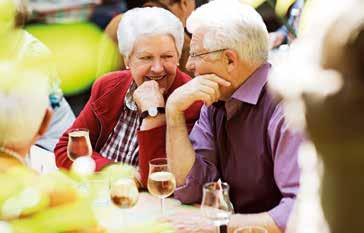
Mainz, the state capital of Rheinland-Pfalz, is also the capital of Rheinhessen. In 2008, the city joined an illustrious circle – the Great Wine Capitals Global Network. It is composed of ten towns from the major wine regions of the world. Besides Mainz these are Adelaide, Bilbao, Bordeaux, Lausanne, Mendoza, Porto, San Francisco, Valparaiso and Verona. The organisation’s aim is to promote tourism and wine culture. The earth is a wine planet – and Germany and Rheinhessen are part of it.
The soils of Rheinhessen are primarily shaped by quartzite, porphyry, slate and volcanic rock as well as characteristic deposits from the Tertiary Period. These minerals are then complemented by a much older, geographically remarkable red slate soil that famously rises in the eastern part of the region at the “Roter Hang” (“Red Slope”) near Nierstein and in the west in a subregion called the Rhine-Hesse Switzerland. Many different grape varieties thrive in Rheinhessen’s diverse soils and microclimates, with some individual vintners harvesting and producing 30 or more different wines per year.
White varieties outnumber red by 71 to 29 percent. Silvaner is the region’s traditional workhorse variety, and Rheinhessen in fact has the largest acreage of Silvaner anywhere in the globe. Riesling, Müller-Thurgau and Pinot varieties are also grown here. Red varieties of note include Dornfelder, Pinot Noir and Portugieser. “Winzersekt,” sparkling wine produced in a traditional manner according to strict quality criteria, has grown into a top seller in the 30 years since the classification was introduced. The region is also marked by little huts known as Trulli (singular: Trullo). There are 30 – 40 of these small round vineyard huts with domed roofs dotting Rheinhessen vineyards. They are often painted brilliant white and lend their surroundings an almost Mediterranean feel. Originally intended as housing or shelters for vintners and vineyard workers, they have survived the passage of time because they are built of stone, reflecting the scarcity of wood in Rheinhessen.
Vineyard area: approx. 26,800 ha, 71% white wine Most important grape varieties: Riesling, Müller-Thurgau, Dornfelder, Silvaner, Grauburgunder, Spätburgunder, Weißburgunder Further information: www.rheinhessen.de
• Kloster Engelthal in Wasem • The Liebfrauenstift-Kirchenstück in Worms • The Niersteiner Glöck • The Kupferberg Visitors’ Center in Mainz Roter Hang, Nierstein



Saale-Unstrut – Sumptuous Wines, Singular Landscapes
Unstrut Saale
Freyburg ·
Naumburg · · Weimar
Vineyard area: approx. 790 ha, 74% white wine Most important grape varieties: Müller-Thurgau, Weissburgunder, Riesling Further information: www.weinbauverband-saale-unstrut.de
• Rotkäppchen sparkling wine cellars • The vineyard huts • The “Stone Picture Book” at Naumburg The vineyards of the Saale-Unstrut winegrowing region are located in southern Sachsen-Anhalt near Freyburg and Naumburg, in northern Thüringen around Bad Kösen and on roughly 790 hectares of land in Brandenburg, to the southwest of Berlin. One small exclave, the Werderaner Wachtelberg, lies just eight kilometers west of Potsdam, at a latitude of approx. 51 degrees north. Its six hectares represent the northernmost vineyard in Europe approved by the EU for the production of quality wine.
The Saale and Unstrut rivers run through an old cultural landscape characterized by steep terraces, stone walls, orchards and river meadows. Wine has been cultivated here for over a millennium.
THE BEAUTY OF THE LANDSCAPE HAS DRAWN PEOPLE SINCE TIME IMMEMORIAL.
The Bronze Age Sky Disk of Nebra, unearthed in 1999, offers evidence of the age of this cultural landscape. It is considered the oldest celestial representation in the world.
Medieval: Naumburger Cathedral


Wine bar in Freyburg
The first verified mention of winegrowing on the Saale and Unstrut rivers dates back to 998 and deed documents from Emperor Otto III that cite viticulture as part of a donation. Average temperatures in this region are relatively low, and vines require protected vineyards to grow here. Vintners of yore observed heat islands in places like river valleys and used those insights to find microclimates that allow the grapes to flourish beautifully. These climatic conditions inherently lead to a natural reduction in yields, and so harvests along the Saale and Unstrut average a mere 50 hectoliters per hectare.
Müller-Thurgau is the most common grape variety cultivated on the Saale and Unstrut, with the relatively low yields lending the wines an enhanced finesse. The same is also true for the next two most popular varieties, Weißburgunder (Pinot Blanc) and Silvaner. Delicate and lively with fresh acidity – this describes best the character of the fine wines from the Saale, the Unstrut and the Wachtelberg. Be sure to try the wines locally, as they rarely leave the region, especially the rare red wines.

The “Romantic Road” and the “Skywalk” run along the Saale-Unstrut Wine Route. Castles and palaces such as the Neuenburg and the Rudelsburg, historical edifices like Naumburg Cathedral and mystical places such as excavation site of the Sky Disk of Nebra are all part of the cultural history of the country. Freyburg on the Unstrut is considered the region’s unofficial wine capital. It is host to the region’s largest wine festival, held every year on the second weekend in September. A wide swath of visitors come to explore this winegrowing region and its wines, vineyards, wine taverns and seasonal wine bars, taking advantage of the well-developed network of cycle paths, walking tracks and waterways. The largest part of the winegrowing region is located in the Saale-Unstrut-Triasland conservation area.

Sachsen – Cool Climate Saxony, Winemaking Visionaries
Meißen
Elbe
· Meißen
· Radebeul
Dresden ·
· Pirna The Sachsen region is located to the north and south of Dresden, roughly between Meißen and Pirna. With about 500 hectares it is one of the three smallest wine-growing regions in Germany and the most easterly. Poland is only a stone’s throw away.
The continental climate, which means warm summers and cold winters, defines winegrowing in Sachsen. The alternation of mild day and cool night temperatures is very good for the vines. The Sachsen wines – mainly
Müller-Thurgau, Riesling and Pinot Blanc – prove this impressively with their delicacy. It is believed that a bishop named Benno planted the first vines near Meißen in the eleventh century. Saxon viticulture was documented in 1161, which is why Sachsen celebrated its 850th anniversary of winegrowing in 2011.
While scholars may still debate the exact dates, every vintage of Sachsen wine is worth celebrating!

THE BLUE RIBBON OF THE ELBE RUNS THROUGH A LOVELY LANDSCAPE DOMINATED BY VINEYARD TERRACES AND HISTORIC VILLAGES.
Vineyard area: 500 ha, 82% white wine Most important grape varieties: Müller-Thurgau, Riesling, Weissburgunder, Grauburgunder Further information: www.weinbauverband-sachsen.de
• Schloss Wackerbarth • Hoflößnitz and the club-shaped bottle
Dresden, a city long noted for its urban beauty, sits like a gemstone at the center of this winegrowing region. The landscape is marked with dry stone walls that are not only picturesque but also important for the region’s flora and fauna. They help bound the steep slopes and form the region’s characteristic terraces, while also offering a habitat to rare plants and animals.
White grape varieties predominate in Sachsen, outnumbering red varieties by 82 to 18 percent. Less than one percent of all German wines come from Sachsen, and Sachsen wines are rarely found outside their home market. All the more reason to visit and enjoy the wines locally!
One native specialty merits special mention: Goldriesling, which is cultivated on just 27 hectares of vineyard. Goldriesling is light and fresh, typically drunk young and brings a delicate spicy note. Pastor Sebastian Kneipp, an early evangelist of healthy living, recommended this wine to accompany his health treatments in the 19th century. Another good reason to try it!


Schloss Wackerbarth
The Franconians have their famous Bocksbeutel bottle, while the Saxons have the club-shaped Keule. It resembles a bowling pin and was invented in 1931 at the Viticultural Research and Teaching Institute of Hoflößnitz, near Dresden. With a museum, wine bar and vineyard, Hoflößnitz remains a fascinating center of Saxon wine culture.
Württemberg –Cultured Hills of Reds and Whites
The federal state of Baden-Württemberg is home to two different winegrowing regions, Baden and Württemberg. Each has its own highly distinctive character.
With around 11,500 hectares under vine, Württemberg is the fourth-largest German winegrowing region. With 68 percent of all plantings, red grapes are the dominant force here. First and foremost comes amicable
Trollinger, but other favorites of Württemberg vintners include Pinot Meunier (Schwarzriesling), Lemberger and
Pinot Noir (Spätburgunder). Riesling is grown on roughly 2,000 hectares, making it the most important white wine variety in Württemberg.
The winegrowing area of Württemberg is located on the Neckar River and on its tributaries Rems, Enz, Tauber, Kocher and Jagst. There is also a Württemberg wine enclave on the Bavarian banks of Lake Constance near
Lindau.
Vineyard area: approx. 11,500 ha, 68% red wine Most important grape varieties: Trollinger, Riesling, Lemberger, Schwarzriesling, Spätburgunder Further information: www.wwg.de
• Winzerhof Gierer in Nonnenhorn • Weingut Wilhelm Kern in the Remstal • Sparkling wine manufacturer Kessler in Esslingen • Hornberg castle in Neckarzimmern • Pfedelbach and the barrel of the prince Rhein
· Neckarzimmern Heilbronn · · Pfedelbach · Stuttgart Neckar · Esslingen
Meersburg · Lindau
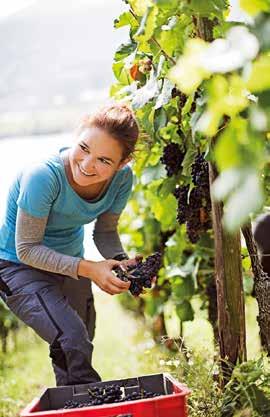

THE HILLY LANDSCAPE ALONG WÜRTTEMBERG‘S RIVERS BEARS WITNESS TO ITS GEOLOGICAL HISTORY.
Romantic timbered buildings in Niederhall
Many of the hills here have a distinct cone shape, an indication that they are of volcanic origin. The town of Weinsberg is just five kilometers east of Heilbronn and is home to the prestigious State Education and Research Institute for Viticulture and Pomology. It has served as the incubator for important grape varieties such as Kerner and Dornfelder.
Wine was long considered a “staple food” in Württemberg, not unlike beer in Bavaria. Up through the First World War the smallest measure of wine available in a pub was a half-liter “Schoppen.” Most wine produced in Württemberg is consumed locally, frequently in cozy countryside wine taverns known as Besenwirtschaften. These are run by the winemakers themselves and only open during the summer season.
Wine cooperatives have a long and strong history in Württemberg. Many vintners, or vine dressers as they are called here in Württemberg, are part-time winegrowers who deliver their grapes to cooperatives. Of course, there are also many independent wineries in the region that market their wines themselves.
One local specialty is called Schillerwein. Unlike other rosé wines, Schillerwein is made from a mixture of red and white grapes mixed together prior to fermentation. The term “Schillerwein” is not related to the great Württemberg poet Friedrich Schiller, but rather has its origins in the Middle Ages.

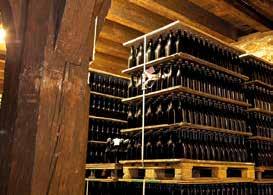
Sommeliers, wine connoisseurs and residents of regions where wine is grown know that every style of wine has its own traditional glass. Even so, Württemberg’s favorite vessel for wine drinking stands out: a glass mug. Found primarily in traditional wine taverns, it is Germany’s only classic wine glass without a stem — but does have a convenient handle on its side. Württembergers drink more wine per capita than residents of all the other regions in Germany.









